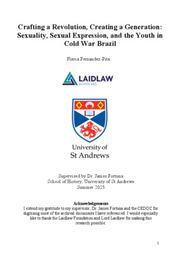A change is as good as a rest (04/06/2025)

Lampião de Esquina was one of Brazil’s first newspapers that was specifically targeted at a queer audience. Running from 1978-1981, it rode on the wave of the abertura, the period of liberalisation during the dictatorship. It has so far been my favourite source to analyse, and I have gathered a lot of information from each edition. However, when I was looking down at an 1980 edition of Lampião [1], I realised that I could not keep going. My eyes were glazing over the pages, and I was not retaining any information. I realised then that I had been reading about homophobia and the regime’s (largely negative) attitudes towards the queer community for over three hours, non-stop. Now, do not get me wrong, I find the topic fascinating, it is, after all, a central part of my research project, but it had gotten to the point where I could not do it anymore. I would have called it a day, gone home, and enjoyed the few moments of sunshine that Scotland gets. But alas, it was 11:00, and despite my proclivity to give myself extended breaks, I could not justify leaving the library that early.
However, I felt energised, I was not tired from reading, but I was just tired of reading about nothing else. So, I decided to think about my general understanding of the period itself. Was I missing something? What did I not fully grasp? Unfortunately, that happened to be the structure of the military regime itself. I say “unfortunately” because anyone who has tried to discuss any type of history with me will know that I cannot stand military history. I derogatorily call it “boy history”. However, seeing as the dictatorship was a military dictatorship and that a big part of my project is about oppression, I could not get away with not understanding it. That is when I started reading Alfred Stepan’s “Rethinking Military Politics: Brazil and the Southern Cone” [2].
I started with the first chapter, then the second, the third, and eventually I realised I had read five chapters out of seven (the last two chapters discussed post-dictatorship Brazil, which is outside the scope of my project). The book is only 192 pages, so it did not take me too long to read. But the book teased me, in a way, as it was generally not entirely relevant to my research, but in every chapter, there was a paragraph or two, hidden within walls and walls of text, that was very useful, so I had to keep reading. I then read other texts to understand oppression during the regime, in particular Moreira Alves’s "Cultures of Fear, Cultures of Resistance: The New Labour Movement in Brazil.” [3] This has nuanced my argument, as it has opened the door to a comparison between the treatment of leftists and the queer community as separate as the left was not accepting of queerness at the time.
Do I understand the structure of the military regime? Possibly. Am I still very confused? Absolutely, but I am not too worried about it. It is the type of confusion that comes from knowing a lot about a certain topic, so you know what parts of it you do not understand. Essentially, the opposite of the Dunning-Kruger effect[4]. It is 16:00 now and I am excited to get back to Lampião de Esquina and finish analysing that lovely 1980 July edition that I was talking about before. After all, a change is as good as rest, at least sometimes.
References
[2] Stepan, Alfred, Rethinking Military Politics: Brazil and the Southern Cone (Princeton, 1988).
[3] Moreira Alves, Maria Helena. "Cultures of Fear, Cultures of Resistance: The New Labor Movement in Brazil" in Juan E. Corradi, Patricia Weiss Fagen and Manuel Antonio Garretón (eds.), Fear at the Edge: State Terror and Resistance in Latin America (Berkeley, 1992), pp. 184-211. https://doi-org.ezproxy.st-andrews.ac.uk/10.1525/9780520912205-011
[4] https://www.verywellmind.com/an-overview-of-the-dunning-kruger-effect-4160740




Please sign in
If you are a registered user on Laidlaw Scholars Network, please sign in